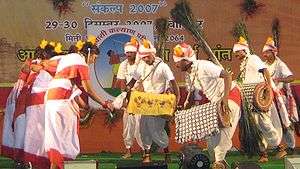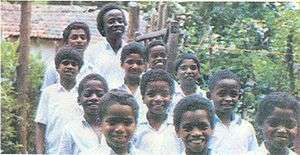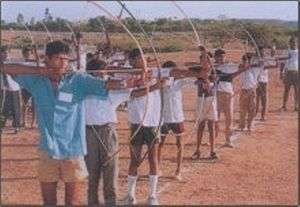Vanavasi Kalyan Ashram
 | |
| Founded | December 1952 |
|---|---|
| Founder | Balasaheb Deshpande |
| Type | Tribal emancipation |
| Focus | Tribal and indigenous communities of India |
| Location |
|
Area served | Health care, education, Preserving tribal culture |
| Slogan | Nagaravāsi Grāmavāsi Vanavāsi We Are All Bhāratavāsi |
| Website |
www |
Vanavasi Kalyan Ashram is an Indian social welfare organization based in Jashpur, in the Chhattisgarh state of India. It focuses on indigenous tribes in remote areas of India and has branches all over India. These branches focus on agriculture, healthcare, child education, and sports and culture in their respective regions.[1] It also has the mission to `Hinduise the adivasis (tribals)' through conversion and reconversion activities.[2] The organization is a constituent of the Sangh Parivar, the family of organisations affiliated with the Hindu nationalist Rashtriya Swayamsevak Sangh (RSS).[3][4]
History
The Ashram was founded in 1952 by Ramakant Keshav Deshpande, an official of the Orissa State Department of Tribal Welfare, with the support of the State Government and the RSS. Its aim was to counter the appeal of Christian missionary schools to the tribals. Based in Jashpur (214 km from Raigarh), it established schools in Raigarh and Surguja districts - areas with large tribal populations. The Ashram grew rapidly and a permanent office was established in 1963, inaugurated by the RSS chief M. S. Golwalkar.[3]
In 1977, during the Janata Party Government, it acquired national status (expressed in its new name, Bhāratiya Vanavāsi Kalyān Āshram). From 1978 to 1983, the number of its full-time volunteers rose from 44 to 264 (56 of whom were tribal). In Jashpur, a hospital was established, and schools, hotels, and centers for apprenticeship in manual trades were also established in 40 villages. The programs are presently located in 312 districts throughout the country and are supervised by more than a thousand full-time workers. While most districts have primary schools, many other places have residential schools, hostels, libraries, and health centers. Important annual events include establishing medical camps, playing traditional sports, and celebrating tribal festivals.[3]
During the last two decades, the Ashram has intensified its activities in the tribal areas, coupling anti-Christian propaganda with conversion to Hinduism. Hindu religious leaders with RSS affiliations, such as Swami Aseemanand in Dangs (Gujarat), Swami Lakshmanananda in Orissa, Asaram Bapu in the Jhabua region of Madhya Pradesh, and Narendra Maharaj in Maharashtra, have set up ashrams and extended their influence among the tribals. All these regions have seen heightened communal violence against Christian communities.[2]
Mode of operation

Economic development
The tribal communities in India suffer from a lack of both education and proper health care facilities due to various factors including government neglect. As a result, the communities often have a sense of alienation from present-day India which is being rapidly urbanized and westernized. To bring them into the mainstream with economic development but with their cultural moorings intact is an important role of the Kalyan Ashram. The Vanavasi Ashram helps the communities protect their interests and assists them to solve their own problems.[5]
The Vanavasi Kalyan Ashram helps with the formation of people's self-help groups. It also encourages smaller gatherings in post offices, provides training for scientific cultivation of cash crops, distributes seeds and seedlings, and helps arrange local resources for irrigation. It also helps widows and the elderly get their pensions. The Ashram increases people's awareness by organizing occasional symposiums on current issues like "Impact of Globalization and Liberalization on Tribal Life" and publishing books and periodicals dealing with socio-cultural aspects of day-to-day tribal life.[1]
The Ashram, by providing the basic amenities like health care, employment, and education, helps the tribes avoid activity that can hamper their development. Their efforts are also directed at conflict resolution between the different tribes, which sometimes clash amongst themselves over petty issues. The Ashram has been promoting the concept that all the tribal groups belong to India and hence are one.[5]
Education

The Ashram has a network of single teacher schools (Ekal Vidyalaya) across tribal areas where there are no government schools, based on Swami Vivekananda's saying, "If the mountain does not come to Mohammed, Mohammed must go to the mountain. If the poor cannot come to education, education must reach them at the plough, in the factory, everywhere." Many tribal people are now serving in higher government posts at the central and state level. Almost 90% of Hindi teachers in Nagaland state are products of Kalyan Ashram hostels, as well as one medical officer serving in the central government in Delhi. Many of the Ashram's former students have been selected for state police services.[5]
Tribal sports

The Vanvasi Kalyan Ashram has hundreds of sports facilities and centers across the tribal areas of the countries that promote tribal sports, especially archery. Students from schools and hostels run by the organization have won laurels in archery at national and international levels.[5]
Archery
Accomplished Indian archer and Padma Shri recipient Limba Ram, whose family belongs to the Ahari tribe, was a student of the Vanavasi Kalyan Ashram in Saradeet Village, Rajasthan who would go on to win many medals as well as represent India thrice at the Olympic Games. Many other students from different schools of the Ashram across India have won medals at state and national levels in games conducted by the Sports Authority of India. The Ashram has various centers across the country where basic infrastructure is provided to train them in archery and help them preserve the tribal games.[5]
Kavita Raut, a medalist in the 10,000-meter run at the Commonwealth and Asian Games, and who studied at Vishva Hindu Parishad Nasik, now trains at SAI Bangalore for better performance for the forthcoming Olympic games.
Protecting culture
The Vanavāsis ("Tribals") were called Aboriginals and made victims of the divide and rule policy of the British. They were declared to be animists with no religion worth the name. The tribal regions were scaled off as "Protected Areas" to all except Christian missionaries. Now, the Vanavasi Kalyan Ashram has begun working in those areas. Sanskar Kendras for women and children, schools, hostels, reading rooms, free dispensaries, and village and cottage industries have been started and are increasing in number throughout all the provinces.
The Ashram helps the tribes protect their rich cultures. It organizes performances of traditional folklore and dances like Kolatam, Chakka Bhajana and Dhimsa dance.[5] Among the several events, the important ones include medical camps, traditional sports, and the celebration of Tribal festivals as well as major Hindu festivals, like Raksha Bandhan, Hanuman Jayanti, Ram Navami, Govardhan Puja, Indal Pooja and Krishna Janmashtami.[1]
See also
References
- 1 2 3 Rath, Govinda Chandra (2006). Tribal development in India.
- 1 2 Uma & Grover 2010, p. 32.
- 1 2 3 Jaffrelot, Christophe (1996). The Hindu nationalist movement and Indian politics: 1925 to the 1990. London: C Hurst & Co. (Publishers) Ltd. pp. 322–323. ISBN 1-85065-301-1.
- ↑ "Adivasi vs Vanvasi: The Hinduization of Tribals in India". Outlook. 20 November 2002. Retrieved 2014-12-08.
- 1 2 3 4 5 6 "Aiming high: Vanavasi Kalyana Ashram is helping tribal groups achieve self-reliance", The Hindu, Feb 25, 2006.
- Sources
- Uma, Saumya; Grover, Vrinda (2010), Kandhamal: The Law must Change its Course, New Delhi: MARG: Multiple Action Research Group, ISBN 978-81-87377-19-1
External links
- Official Website
- Official Karnataka State branch website
- Official Maharashtra State branch website
- Official New Delhi Union Territory branch website
- From drought to lush forest
- Vanavasi Kalyan Ashram to form women committees in all Vanvasi districts
